| Part of a series on Islam Sufism |
|---|
 |
|
|
Shah Wajihuddin Alvi Gujarati (Persian: شاه وجیه الدین علوی گجراتی), also known the epithet Haider Ali Saani (Persian: حیدر علی ثانی), was an Islamic scholar and Sufi in the Shattari tradition.
Life
Wajīh al-Dīn ʿAlawī Gujarātī was born in Ahmedabad in 1504 into a family of Sufi scholars and jurists. In 1528 he founded the ʿAlawī Madrasa which was Ahmedbad's most notable Islamic learning center for over a century and a half. He was made a member of the Shattariyya order by Muhammad Ghawth Gwāliyārī. Under his leadership, Ahmedabad became a major centre of Islamic studies, attracting students from all over India, and many of his disciples became prominent figures, including Syed Sibghatallah al-Barwaji, who moved to Medina and established the Shattari tradition in Saudi Arabia, Sheikh Abdul Qadir, who settled in Ujjain, and Sheikh Abu Turab, who moved to Lahore, and students from Bengal such as Usman and Yusuf, who contributed to Islamic education in medieval Hindustan.[1][2] He passed away in his madrasa in 1590.[3]
Works
Wajihuddin Alvi is reported to have written books in Arabic and Persian.[4]
- Hashiya Alvi Ala Tafsir Baydawi حاشية العلوي على تفسير البيضاوي
- Sharh Nuzhat Al-Nazar شرح نزهة النظر للكجراتي مع نخبة الفكر للعسقلاني
- Hashiya Alvi ala Sharh al-Jami حاشية علوي على شرح الجامي
- Aidah Haqiqat Sharh Haqiqat Muhamadi ايضاح حقيقت شرح حقيقت محمدي
Shrine

He passed away in 1580 CE.[5] He is buried in a memorial tomb in Khanpur, Ahmedabad, that was built by his disciple Syed Murtuza Khan Bukhari, the eleventh (1606–1609) governor of Ahmedabad during the reign of Jahangir.[6][7][8]
References
- ^ al-Kumillai, Muhammad Hifzur Rahman (2018). "الشيخ الفاضل عثمان بن أبي عثمان البنغالي" [The honourable Shaykh ʿUthmān bin Abī ʿUthmān al-Bangālī]. كتاب البدور المضية في تراجم الحنفية (in Arabic). Cairo, Egypt: Dar al-Salih.
- ^ (۶۰۸) یاد شیخ یوسف بنگالی رحمہ اللہ. Gulzar-e-Abrar (in Urdu). pp. 358–359.
- ^ Kugle, S. (2010). "Alawī, Wajīh al-Dīn". In Fleet, K.; Krämer, G.; Matringe, D.; Nawas, J.; Stewart, D.J. (eds.). Encyclopaedia of Islam Three Online. Brill.
- ^ Khayr al-Din al-Zirikli; Zirikli (2002). Al-Alam. Islam Kotob. p. 110.
- ^ Nūrulḥasan Hāshimī; Valī (1986). Wali. Sahitya Akademi. p. 13.
- ^ Trimingham, John Spencer and Voll, John O. (1998). The Sufi orders in Islam. Oxford University Press USA. pp. 97–98. ISBN 0-19-512058-2.
{{cite book}}: CS1 maint: multiple names: authors list (link) - ^ Achyut Yagnik (2 February 2011). Ahmedabad: From Royal city to Megacity. Penguin Books Limited. p. 42. ISBN 978-81-8475-473-5.
- ^ Gazetteer of the Bombay Presidency: Ahmedabad. Government Central Press. 1879. p. 278.
dastur khan mosque.


Recent Comments